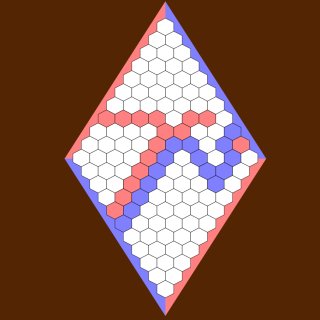
Hex for iPad
by Luigi Fonti
Hex is a strategy board game played on a hexagonal grid, theoretically of any size
and several possible shapes, but traditionally as an 11x11 rhombus.

History
The game was invented by the Danish mathematician Piet Hein,
who introduced it in 1942 at the Niels Bohr Institute.
It was independently re-invented in 1947 by the mathematician John Nash at Princeton University.
Hex is an abstract strategy game that belongs to the general category of "connection" games.
Rules
Each player has an allocated color, Red and Blue being conventional.
Players take turns placing a stone of their color on a single cell within the overall playing board.
The goal is to form a connected path of your stones linking the opposing sides of the board
marked by your color, before your opponent connects his or her sides in a similar fashion.
The first player to complete his or her connection wins the game.
The four corner hexagons each belong to both adjacent sides.
The turn of each player is shown by a red or blue disc on a side of the board game.
The player must touch a cell to fill it with his own color.
After that, he can cancel his last move using the 'Undo' button, and redo a different move.
When the move is done, the turn comes of the opponent player.
Notes
John Nash proved in 1952 that a game of Hex cannot end in a tie, and that for a symmetric board
there exists a winning strategy for the player who makes the first move (by the strategy-stealing argument).
However, the argument is non-constructive: it only shows the existence of a winning strategy, without describing it explicitly.
Finding an explicit strategy has been the main subject of research since then.